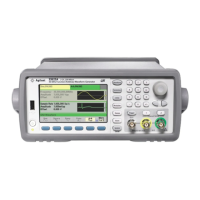Introduction to Calibration
Introduction to Calibration
This chapter contains procedures for verification of the instrument's performance and adjustment (calibration).
The instrument uses closed-case electronic calibration; no internal mechanical adjustments are required. The instru-
ment calculates correction factors based on input reference values that you set and stores correction factors in non-vol-
atile memory until the next calibration adjustment is performed. This data is not changed by cycling power or *RST.
Agilent Technologies Calibration Services
Your local Agilent Technologies Service Center offers low-cost recalibration. The service center uses automated cal-
ibration systems that allow Agilent to provide calibration at competitive prices.
Calibration Table of Contents
The section includes the following sections:
Calibration Overview
l Calibration Interval
l Adjustment is Recommended
l Time Required for Calibration
l Automating Calibration Procedures
l Recommended Test Equipment
l Test Considerations
l Calibration Count
l Calibration Message
Calibration Security
Performance Verification Tests
l Self-Test
l Quick Performance Check
l Performance Verification Tests
l Amplitude and Flatness Verification Procedures
Internal Timebase Verification
AC Amplitude (high-impedance) Verification
DC Offset Voltage Verification
-8 dB Range Flatness Verification
-24 dB Range Flatness Verification
General Calibration/Adjustment Procedure
Aborting a Calibration in Progress
Sequence of Adjustments
Self-Test
Agilent 33500 Series Operating and Service Guide 369

